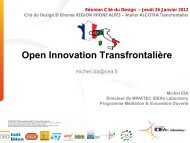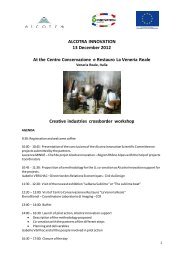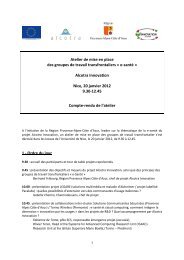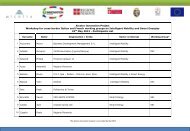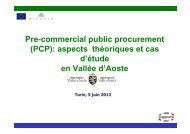Best practices Database for Living Labs - ALCOTRA - Innovation
Best practices Database for Living Labs - ALCOTRA - Innovation
Best practices Database for Living Labs - ALCOTRA - Innovation
Create successful ePaper yourself
Turn your PDF publications into a flip-book with our unique Google optimized e-Paper software.
category within the interoperability cube describes different methods and tools used within the existing<br />
European <strong>Living</strong> Lab at all stages.<br />
Integration of the project in the <strong>Living</strong> Lab infrastructure: A full <strong>Living</strong> Lab service offering not only<br />
requires product and service development and evaluation methodologies but also a mechanism <strong>for</strong> the<br />
integration of the customers’ product or service into a <strong>Living</strong> Lab to provide it to the users. The efficient,<br />
transparent and smooth integration accomplished by the <strong>Living</strong> Lab provider is the key <strong>for</strong> trust and<br />
convenience of the customer. It also can work as a first product/service testing depending on the level of<br />
development (market launch testing).<br />
Co-creation: The core service of the <strong>Living</strong> Lab is to facilitate the co-creation of a product, service or<br />
application development. This co-creative product development process can be decomposed into four<br />
phases: Product Idea, Product Concept, Product Development, and Market Launch. For the four phases<br />
specific methods <strong>for</strong> user integration are assigned.<br />
Data preparation: To fulfil the customers’ expectations regarding the results and to reduce the<br />
complexity of the evaluated data, the <strong>Living</strong> Lab provider offers a standardised data preparation. The great<br />
advantage of the standardisation is the comparability with the results of other <strong>Living</strong> <strong>Labs</strong>. .<br />
13.7 Supporting SME <strong>Innovation</strong><br />
SMEs are by far the most important category of companies. Within the European Union about 23 million<br />
SMEs provide around 75 million jobs and represent 99% of all enterprises. Their role in the regional and<br />
national innovation system as creators of new products, services and markets and partners <strong>for</strong> larger<br />
companies is really crucial. As globalisation of markets and industries continues, these innovation systems<br />
become more and more open and cross-border. SMEs must be able to participate in international value<br />
networks in order to survive. Networking capabilities and competencies to engage in open innovation<br />
there<strong>for</strong>e must be enhanced.<br />
There is a need to introduce new solutions enabling SMEs participation into the innovation process. The<br />
<strong>Living</strong> <strong>Labs</strong> concept, based on ICT-based services and open innovation, offers the new organizational<br />
dimension, processes, services and ICT-infrastructures to improve SME competitiveness and innovation<br />
potential and to enable SME to become protagonist on the innovation process, through partnership<br />
building among themselves and in collaboration with supporting institutions, such as university research<br />
centres and regional development agencies.<br />
13.8 Indicator Wrap-up<br />
A best Practices Assessment was conducted <strong>for</strong> selected <strong>Living</strong> <strong>Labs</strong> taking investigating the dimensions<br />
defined above as part of the CO-Llabs project. The goal was to provide benchmarks <strong>for</strong> other <strong>Living</strong> Lab in<br />
order to allow a self-positioning of <strong>Living</strong> <strong>Labs</strong> as part of a self-assessment. The Study should provide hints<br />
about the level of sustainability and to share good <strong>practices</strong> within ENoLL. The results are available as<br />
spider-web diagrams as presented in<br />
Figure 28.<br />
The project is co-funded by the ERDF<br />
Page 70 of 78



